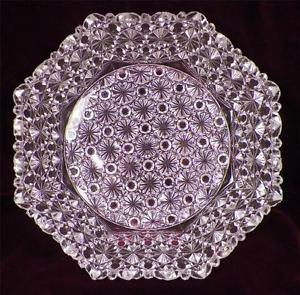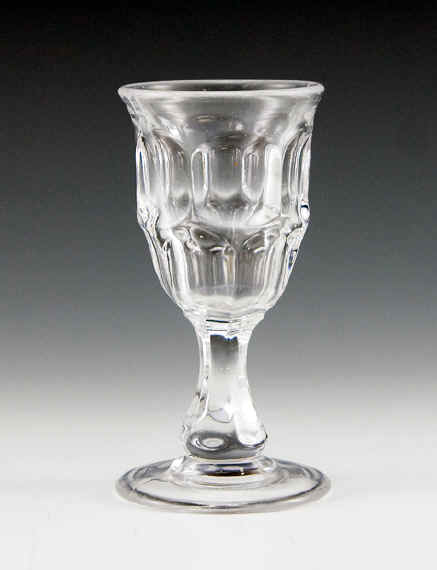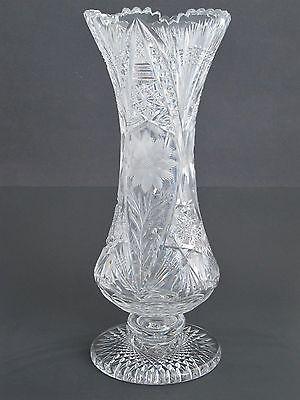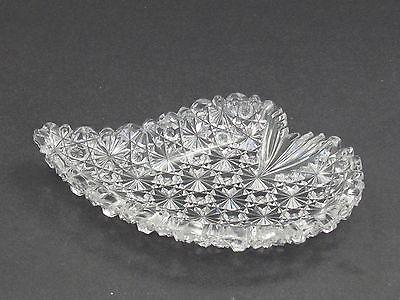 Simply
because cut glass has always been expensive, it has been imitated. To
the collector, however, nothing is as good and no comparison can be
made. Sometimes, however, identification is difficult. There were
four kinds of glass made to imitate cut glass; blown - molded, pattern
pressed lead, pattern pressed lime and glass cut on fine finished
pressed blanks.
Simply
because cut glass has always been expensive, it has been imitated. To
the collector, however, nothing is as good and no comparison can be
made. Sometimes, however, identification is difficult. There were
four kinds of glass made to imitate cut glass; blown - molded, pattern
pressed lead, pattern pressed lime and glass cut on fine finished
pressed blanks.
Blown - molded glass has
been blown into a mold in which a pattern has been cast. Many of these
patterns mimic original cut glass patterns, but the outline of the
design is too smooth and rounded to have been cut. Blown - molded glass
itself is now collectible and prized by those who seek it.
Pressed lead glass, made around 1830, also copied patterns of cut glass
but the pattern again made the edges soft and rounded, not sharp as if
cut. Pressed lead has the ring of cut glass, but the piece will lack the
prismatic luster.
 Pressed
lime glass was made after 1865 in large quantities and in many patterns.
Many of the patterns were designed specifically for the press and could
never have been cut because of their complicated designs. After 1880,
and during the Brilliant Period when the fever was high for cut glass,
many manufacturers pressed lime glass into patterns that are exactly
like simple cut glass patterns. The most obvious was the daisy and
button pattern that duplicated the star and hobnail.
Pressed
lime glass was made after 1865 in large quantities and in many patterns.
Many of the patterns were designed specifically for the press and could
never have been cut because of their complicated designs. After 1880,
and during the Brilliant Period when the fever was high for cut glass,
many manufacturers pressed lime glass into patterns that are exactly
like simple cut glass patterns. The most obvious was the daisy and
button pattern that duplicated the star and hobnail.
Pressed blanks usually had
the first deep incisions already pressed in them while the glass was
molten. The process was designed to save the manufacturer the first
cutting by the rougher is hand rubbed to keep from wasting glass by
disposing of the large sections cut away. The sad part of this is that
contact of the molten glass with a press caused the glass to lose its
refraction, so it no longer glistens as if it were cut. Glass cut on
pressed blanks gathers dust more quickly, fogs more easily, and cannot
be polished as brightly. Furthermore, there are slight ridges on the
inside of the piece opposite the deepest cuts on the outside. On fine
cut glass the inner surface dries in the air and is very smooth. On
pressed glass the inside is against the mold opposite a deep cut and
consequently develops the raised places.
 Some
of the positive signs to look for in seeking out cut glass are ring,
sparkle, sharpness and weight. Strike a piece of cut glass with a pencil
or the snap of your fingernail, and it will ring like a bell unless it
has a closed top like a carafe or a bottle. This is due to the lead and
saltpeter used in its manufacture. Some early pressed glass was made of
lead also, will ring, but the ring is shorter, sharper and brittle
because of the lesser amount of lead used as a basic ingredient. It is
not necessarily true, however, that the longer the ring, the better the
quality of the glass.
Some
of the positive signs to look for in seeking out cut glass are ring,
sparkle, sharpness and weight. Strike a piece of cut glass with a pencil
or the snap of your fingernail, and it will ring like a bell unless it
has a closed top like a carafe or a bottle. This is due to the lead and
saltpeter used in its manufacture. Some early pressed glass was made of
lead also, will ring, but the ring is shorter, sharper and brittle
because of the lesser amount of lead used as a basic ingredient. It is
not necessarily true, however, that the longer the ring, the better the
quality of the glass.
The cutting of glass reveals
one of its inherent qualities, its brilliancy. If you hold a piece of
cut glass to the light, you will notice a brilliance in the refraction.
No amount of polishing can replace the refraction lost to the press.
Although the refraction is less than early American pieces due to
impurities in the metal, most cut glass made in America after 1880
refracts light excellently due to the purity of the ingredients and the
quick fusion attained with the hotter furnaces fueled by natural gas.
Also the deeper cuttings in glass of the Brilliant Period made it
sparkle even more. Glass polished on wooden wheels has a more lustrous
appearance too. After 1900 acid polishing was often used for quickness
and economy. Hand polished pieces are more desirable to the collector.
The sharpness refers to the edges. Not only are the edges and points
sharply defined, but they feel sharp. Just imagine the uneven surface
that would be left by a mold.
 Because
of its lead content, cut glass is usually heavy. Sixty pounds of lead
were used for every hundred pounds of sand for the pressed blanks used
for cut glass. With less or without any lead, the piece would weigh
significantly less.
Because
of its lead content, cut glass is usually heavy. Sixty pounds of lead
were used for every hundred pounds of sand for the pressed blanks used
for cut glass. With less or without any lead, the piece would weigh
significantly less.
Cut glass has always been
fine glass. The American cut glass industry took great pride in their
products and made every effort to make American cut glass the finest cut
crystal in the world. American cut glass has always been the best of its
time, as evidenced in the many public and private collections throughout
the United States.
Illustrations from top to
bottom:
Antique Daisy & Button Bowl
Early American Pressed Glass
American Brilliant Period Cut Glass 16" vase
American Brilliant period cut glass Russian pattern heart shape dish